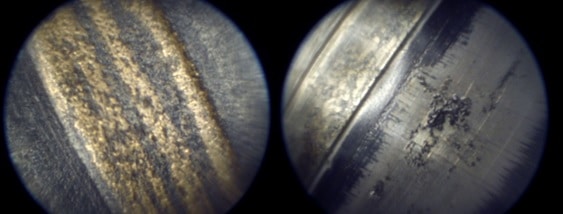
What is a clean Barrel?
It is a barrel free from any buildup of foreign material like gun powder residue or copper fouling in the grooves or anywhere on the lands. Every shooter has to know what the condition of the barrel is at any stage. A clean barrel is also a barrel with all the cleaning solvents and lubricants properly removed. There is a difference between a clean barrel for immediate shooting and a clean barrel for medium term storage. A clean barrel for shooting is squeaky clean and bone dry or it may have traces of lubricant and a clean barrel for medium term storage will be lined with a suitable lubricant for preservation after proper cleaning.
Barrel fouling may vary from the beginning to the end. Normally the first 4 inches are more affected than the rest of the barrel. Over time no part of the barrel is spared from fouling. In other words fouling will show up from the throat to the crown. Inspecting the bore section at the muzzle exit can be a very good indication of the level of fouling and it is also a good indicator to see if a barrel is properly cleaned. All of this can be clearly seen if a borescope is used. A borescope is the most valuable tool to perfect your barrel cleaning routine and is strongly recommended to any serious shooter.
When shooting coated bullets e.g. with Molybdenum Disulfide [Moly-] or Boron Nitride coatings it will be necessary to identify and remove deposits/buildup of these materials as well. Cleaning routine will be slightly different if Moly coated bullets are used. Moly coating definitely prolong the cleaning intervals and is quit easy to remove when cleaning is required.
Aids to identify if your barrel is properly cleaned
1. Look inside with a Borescope
The best tool by far to check barrel condition is a borescope as it magnifies the surface view up to 25 times. It will show the condition of the chamber, throat and the all important condition of the first 4 inches of barrel. A borescope will also reveal barrel wear in general as well as the condition of the lands. As a spin off it is also a magnificent tool and window to the hidden world of barrel fouling and barrel cleaning. Another bonus is that a borescope can also be used to check the condition of the crown. Sadly, very few gun owners can justify the cost of a borescope and so cheaper alternative methods are needed to identify barrel condition.
Borescope pictures:

- On the left: Badly fouled and rusted barrel from a 1908 .303.
- On the right: Good barrel, ruined as a result of pit corrosion likely due to poor cleaning procedure.
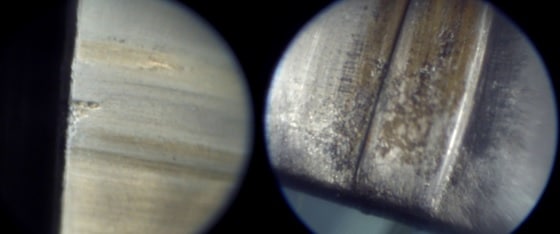
- On the left: Good crown edge with a metal flaw and resulting gas cutting erosion. Hard to spot with the naked eye.
- On the right: Worn out crown and copper fouling on the land.
2. Visual inspection form the outside in
It may sound impossible but there is a lot to be seen from the outside. First remove the action/bolt and look down the barrel into good light. This is the most basic visual inspection. You should see a bright and shiny interior that is smooth and without any sign of internal debris. If the years are moving on and your eye sight has deteriorated it will be difficult to focus close by and deeper into the barrel.
3. Natural light reflected into the barrel
Getting some form of light into the barrel is essential to see what is sitting on the sidewalls and on top of the lands. There are several techniques. Remove the bolt and hold the rifle up into the light, or point it at a white wall with plenty, preferably natural- or sun- light on it. Commercially shaped Perspex bore illuminators are also available that reflect natural light into the barrel. Again standing next to a strong light source will be beneficial. These bore illuminators are sometimes hard to find but this is a very handy tool to improve visual inspection with the naked eye. There is also a flash light version of this type of tool. It is basically the same bended light-conducting Perspex-end with a penlight flashlight mounted on it.
4. Digital camera (smart phone)
Smart phones come with built in cameras. This is a very powerful tool for barrel inspection, more so if your eye sight is not so keen anymore. It is most useful for studying the crown and the last centimeter or ½ inch of the barrel. Insert a small loose fitting piece of white material (anything that is soft and white) at the muzzle and push it only a little bit into the barrel. Judge the depth to reflect light back and create a soft uniform illumination of the interior section of the barrel. Now take the picture from an angle to clearly show the barrel condition. The pictures can be studied for signs of copper or carbon deposits. Even damage or fair wear of the crown may show up.
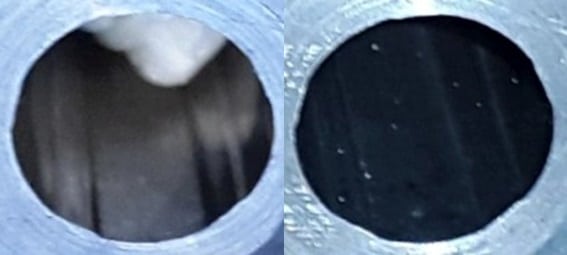
Both pictures were taken with a cellular phone camera of a clean 30cal barrel. The picture on the left show the correct silvery color and was done with natural lighting. The picture on the right could not be done with natural lighting and a flash was used. The benefit of a white object inside the barrel is apparent.
Copper fouling can be seen quite clearly with this method as well. It can also be used to judge if a barrel is properly cleaned.
Good quality pictures are also excellent for record keeping and for future reference and comparison.
Important Note: Always remember to remove any foreign objects inside the barrel after inspection or taking pictures, this can be a serious safety hazard and extreme caution should be used.
5. Inspecting the barrel front end and crown
In stead of using a smart phone camera, the same technique can be used as described in par 2.4 to view the barrel with the naked eye. Any white object inside the barrel will help to get ‘n good clear and well lit view of the crown and front section of the barrel. Copper fouling can be seen quite clearly with this method as well. It can also be used to judge if a barrel is properly cleaned.
6. Inspecting the barrel chamber
It is important to know if the chamber is clean, free from solvents and lubricants and without marks or mechanical damage. This part of the barrel is quite often totally neglected. A borescope is once more the best tool to visually inspect the chamber. A borescope is most effective to look for carbon buildup in the neck area. It can also be used to check for mechanical damage like deep scratches. Without a borescope the only way to check the chamber is to put a clean jag on a large brush into the chamber rub the sides to remove any dirt of solvent or lubricant buildup. The chamber should be free from lubricants. If lubricants are present the friction between the case and the chamber wall is reduced, resulting in the transfer of abnormal forces onto the bolt face.
The indirect method to study the chamber condition is to closely observe how the bolt open and what the cases look like. Excessive dirt or carbon build up will result in stuck cases and poor accuracy.
7. Reading the color of solvents
Copper dissolved by ammonia comes up as a blue color on a soaked patch. This is the most obvious and trusted method used for ages to identify if all traces of copper are properly removed. It is a good idea to use stainless steel or aluminum jags for barrel cleaning. A copper brush or jag can also color the patch blue. If a non copper jag is used there will be no false “blue copper” spots appearing on the patch.
8. Observing shots from the barrel
Copper build up inside the barrel ultimately affects accuracy. Bench rest shooters are very good to pick up the slightest accuracy deterioration and prefer to clean every 15 or less shots. Some hunters shoot the entire hunting season without cleaning and are still happy with their accuracy. Bisley shooters may shoot up to 60 shots a day without cleaning. Extreme long range shooters will also be sensitive to regular cleaning. Some unverified tests have shown that 500 or more shots can be fired from a rifle before cleaning.
To conclude. Barrel fouling behavior is related to multiple factors for example personal use, type of bullets used, bullet construction and material, barrel material, barrel internal surface finish, barrel internal geometry and design, precision required and the number of shots fired or barrel life cycle. Judging the accuracy depends on your application and how well you know your rifle or specific barrel. Copper fouling is a major cause of poor accuracy and it deserves to be mentioned here even if it is very obvious. The only way to identify what your rifle prefer is to practice on the shooting range and to carefully observe emerging trends and patterns. The more you shoot the better your skill will become to judge what your barrel cleaning frequency needs to be.
Related Articles
Introduction to Barrel Care and Cleaning
Good barrel cleaning habits may not be that obvious and can easily be contemplated as a dark art. This is the most important ritual after shooting and the sooner it is done the better. Good barrel care will not only improve you accuracy but it will also greatly improve the life of your barrel.
Barrel Care Part 1: How to know if a barrel is clean
What is a clean Barrel? It is a barrel free from any buildup of foreign material like gun powder residue or copper fouling in the grooves or anywhere on the lands. Every shooter has to know what the condition of the barrel is at any stage.
Barrel Care Part 2: What equipment to use for barrel cleaning
Setting up a proper cleaning kit can be costly. Some of the equipment is convenient and while others are essential. Settling on the right combination is largely a matter of personal preference. In this section all equipment will be discussed as well as their merits.
Barrel Care Part 3: How to clean a barrel
Developing the correct cleaning routine is a lot about common sense and a little about tradition. Due to many recent technological advancements and a huge variety of clean burning powders available today it will be wise to adopt modern gun cleaning practices.
Barrel Care Part 4: How to prepare a barrel before shooting
This section is all about the different techniques that can be used to provide a good form of dry lubrication prior to the first shot. First shot lubrication will also help to get on the button and consistent shot placement from a cold, recently cleaned barrel.


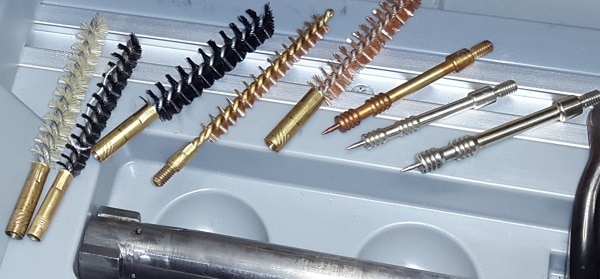
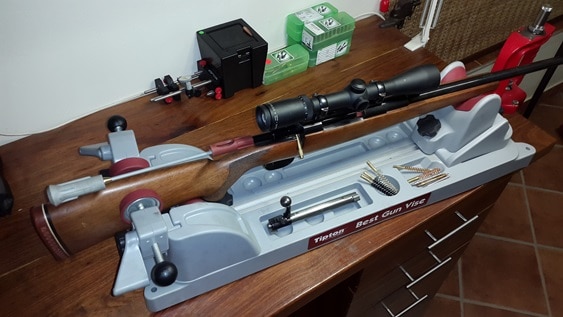
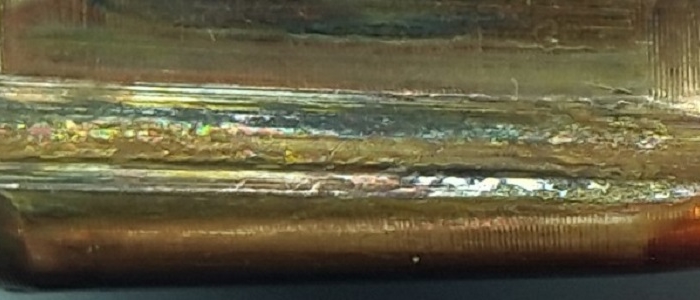
what is the correct procedure when you shoot monolithic bullets….do you need to start with a clean barrel vs a barrel that has copper fouling from previous bullets (e.g. berger bullet).
duh question can you switch shooting different bullet make ups (Copper berger to Peregrine back to berger)?
thanks